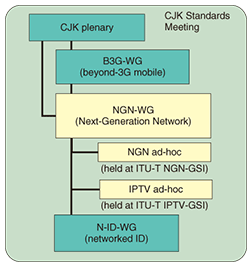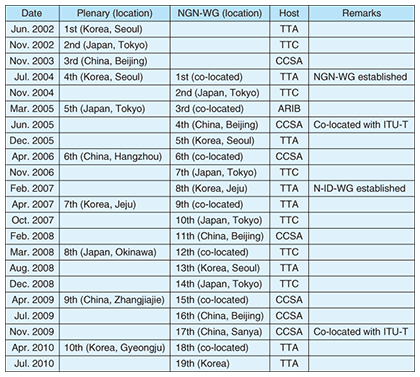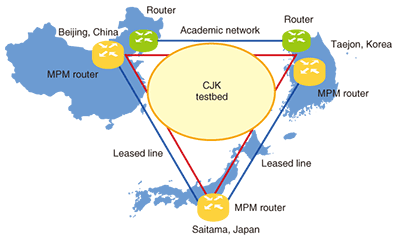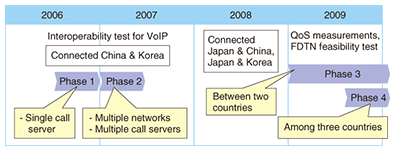 |
|||||||||||||||||
|
|
|||||||||||||||||
|
Global Standardization Activities Vol. 8, No. 7, pp. 50–54, July 2010. https://doi.org/10.53829/ntr201007gls Progress of CJK Standards Meeting and Testbed StudiesAbstractThis article briefly describes current progress of the Next-Generation Network Working Group (NGN-WG) of the CJK (China-Japan-Korea) Meeting on Information and Telecommunication Standards (CJK Standards Meeting). It also describes the study status of the CJK testbed discussed in NGN-WG. The CJK Standards Meeting was started in 2002 by the telecommunication standardization organizations of the three countries contracting to exchange information on the trends of the telecommunication industries in their countries and to cooperate on international standards activities.
1. Overview of CJK Standards MeetingThe CJK (China-Japan-Korea) Meeting on Information and Telecommunication Standards (hereinafter, CJK Standards Meeting) was started in June 2002. It was triggered by the establishment of the China Communication Standards Association (CCSA). The objectives of the CJK Standards Meeting are to exchange information about trends of the telecommunication and information industries in the three countries to grow and evolve those industries and to contribute to international standardization activities through cooperation among the three countries. The CJK Standards Meeting was established by four standards organizations: CCSA in China, the Telecommunication Technology Committee (TTC) and the Association of Radio Industries and Business (ARIB) in Japan, and Telecommunications Technology Association (TTA) in Korea. The CJK Standards Meeting consists of a plenary meeting and three working groups (WGs)—Beyond-3G mobile WG (B3G-WG), Next-Generation Network WG (NGN-WG), and Networked ID-related services WG (N-ID-WG)—as shown in Fig. 1. B3G-WG studies services using mobile telecommunication technologies beyond the third generation (3G). NGN-WG targets Next Generation Network (NGN) standards, including IPTV and future networks. N-ID-WG studies services that use networked identity (ID) technologies. The CJK plenary meeting is held once a year, with the location rotating among the three countries. The host organization chairs the plenary meeting. The history of CJK Standards Meetings is shown in Table 1.
B3G-WG aims to cooperate on standardization activities considering the beyond-3G mobile phone environment. NGN-WG aims to cooperate on standardization activities for NGN, including IPTV, fixed-mobile convergence (FMC), and future networks. N-ID-WG aims to cooperate on standardization activities for services using wireless tags and sensors. From the NTT Group, NTT DOCOMO participates in B3G-WG as a delegate of ARIB, and NTT Laboratories participates in NGN-WG as a delegate of TTC. 2. NGN-WG activitiesThe establishment of NGN-WG was agreed at the CJK plenary meeting in July 2004 in order to cooperate in global NGN standardization activities and exchange information about NGN standards trends in the three countries. Since the first meeting in July 2004, it has met 18 times. The chairman’s term is one year. From NTT, Yoichi Maeda (then a senior research engineer and supervisor at NTT Access Network Service Systems Laboratories) and Naotaka Morita (a senior research engineer and supervisor at NTT Service Integration Laboratories) chaired the WG in 2004 and 2007, respectively. Around 40 people in total attended every NGN-WG meeting. As well as information exchange, the activities of NGN-WG can be divided broadly into two categories: cooperating on NGN standardization in ITU-T (International Telecommunication Union, Telecommunication Standardization Sector) and experimentally studying NGN-related capabilities by using the CJK testbed. Regarding NGN standards cooperation, to coordinate studies in Study Group 13 (SG13) in ITU-T, which standardizes NGN including FMC and future networks, relatively big issues such as the organizational structure of SG13 (i.e., establishment of NGN-GSI (NGN Global Standards Initiative)) and new work items (i.e., beginning a future network study) were discussed and opinions were exchanged before the ITU-T meeting. In addition, the chairman of SG13 (a Korean representative from Electronics and Telecommunications Research Institute (ETRI) and two SG13 vice-chairman (Mr. Morita and a Chinese representative from the China Academy of Telecommunication Research (CATR)) are actively attending CJK NGN-WG. This means that it is possible to confirm management issues directly with SG13 management and to make practical decisions on the operation and management policies of SG13. Therefore, from the Japanese viewpoint, CJK NGN-WG is a valuable forum offering very good opportunities. Moreover, for the exchange of opinions on ITU-T contributions from CJK countries, an NGN ad-hoc meeting has been held during every NGN standards meeting in ITU-T. Similarly, IPTV ad-hoc meetings are also held during IPTV standards meetings in ITU-T to exchange opinions on IPTV-related contributions in ITU-T. 3. Status of CJK testbedThe CJK testbed for testing interoperability and/or feasibility for NGN standards was proposed by TTA of Korea in 2004. CJK began constructing the testbed between China and Korea following TTA’s proposal. CATR in Beijing (China) and ETRI in Taejon (Korea) were connected using the China Education and Research Network (CERNET) and Korea Advanced Research Network (KOREN). Then, both CATR and ETRI were connected to KDDI Laboratories in Japan via leased lines (Fig. 2). There are four test phases, as shown in Fig. 3.
Interoperability tests for VoIP (voice over Internet protocol) services were conducted as test phases 1 and 2 between China and Korea. Interoperability tests between call servers in China and Korea and interworking tests between a VoIP service network and a conventional public switched telephone network were included in test phases 1 and 2. These test phases were closed at the March 2008 NGN-WG meeting. A passive quality of service (QoS) measurement in the CJK testbed was proposed by KDDI Laboratories for studying session control based on user quality of experience (QoE) at the August 2007 NGN-WG meeting and started after test phases 1 and 2. For that purpose, the CJK testbed was extended by two links between KDDI Laboratories & CATR and between KDDI Laboratories & ETRI. Routers having the management of performance measurement (MPM) function were installed in the three parties. KDDI Laboratories and Oki Electric Industry are measuring the QoS of multimedia streams with Real-Time Transport Protocol (RTP) and RTP Control Protocol (RTCP) between Japan & China and between Japan & Korea in the CJK testbed to study end user QoE estimation as phase 3 (Fig. 3). The results already obtained were provided for studying interface specifications between an MPM function and a resource and admission control function (RACF) at ITU-T SG13 Question 4 (Q4/13). It was agreed at the September 2009 Q4/13 meeting to include those results in Y.2111 rev.2 Annex A, and detailed specifications are now being studied. On the other hand, NTT introduced a functionally distributed transport network (FDTN) and proposed feasibility tests on the CJK testbed at the March 2008 NGN-WG meeting. This proposal was agreed, and NTT started an FDTN feasibility test for cooperation with ETRI (Japan-Korea cooperation) as phase 3 (Fig. 3). NTT then conducted a feasibility test for cooperation with CATR and Huawei (Japan-China cooperation) as phase 3. After these two feasibility tests, NTT moved to phase 4 (Fig. 3), which was a feasibility test among all three countries. The results were included to study the independent scalable control plane (iSCP) in ITU-T SG13 Q20 (Q20/13). The iSCP scenario document was agreed as Y Sup.11 at the January 2010 SG13 plenary meeting. A requirements document (Y.iSCP-req) and an architecture document (Y.iSCP-arch) of iSCP are now being studied at Q20/13. 4. Future work planThe CJK Standards Meeting is a loose-knit discussion place compared with European or North American standards organizations because it does not produce its own standards. It is a good place to make contributions toward realistic global standards by discussing the directions of international standards for NGN, IPTV, and future networks in ITU-T and by examining standard specifications by conducting on-the-spot inspections using the CJK testbed. NTT Laboratories will actively participate in CJK Standards Meetings and contribute to the growth of telecommunications and the telecommunication industries in these three countries and to global standards activities. References
|
|||||||||||||||||













